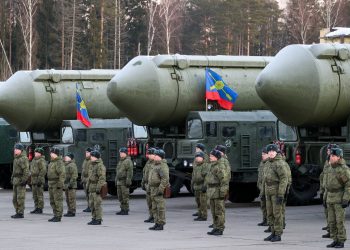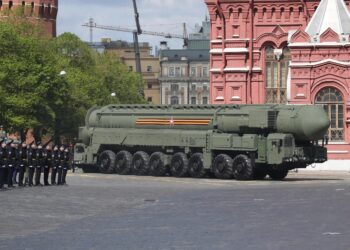US Air Force,
EGLIN AIR FORCE BASE: A three-month process, planned a year in advance, involving hundreds of man-hours of detailed coordination with people at more than four Air Force bases funnels down to one aircraft, one missile, one sortie and the push of a button.
The aircraft is a B-52 Stratofortress flown by an aircrew from the 23rd Bomb Squadron at Minot Air Force Base, N.D. The missile is a modified 3,600 lb. air-launched cruise missile. The sortie is a simulated nuclear missile launch over the Utah Test and Training Range.
The entire process, the Nuclear Weapon Systems Evaluation Program, or NucWSEP, also is known as Combat Sledgehammer and is executed by members of the 53rd Wing's 49th Test and Evaluation Squadron here.
Personnel in the 49th TES, who have managed the program for more than 25 years, perform at least six advanced multi-layered live-fire scenarios per year. The goal is to evaluate every aspect of a nuclear missile launch, from the munitions maintainers to the weapons loaders to the aircrew down to those who fuse and launch the weapon itself.
“These evaluations are the key to ensuring the reliability of our strategic strike capability,” said Larry Hannon, Combat Sledgehammer program director.
The process begins with a yearly order from Air Combat Command officials to conduct the evaluation. Coordination and scheduling are immediately initiated with officials in the 49th TES, located at Barksdale Air Force Base, La.
Coordination and scheduling includes Mission Control Center support from the Utah Test and Training Range for missile release and impact; fighter chase aircraft from the 422rd Test and Evaluation Squadron at Nellis AFB, Nev., to act as safety observers to ensure civil aircraft avoidance outside restricted airspace; tanker aircraft support for refueling; and helicopter support for missile recovery and cleanup operations.
“Due to the high ops tempo of all support assets, early coordination is vital to NucWSEP success,” said Mr. Hannon.
Once a “release” date has been scheduled, movement begins. Two weeks prior to launch, the 49th Logistics Instrumentation and Weapons teams arrive at Minot AFB to install the airborne instrumentation kit and the missile test instrumentation kit. Those kits are telemetry modifications on the B-52 and the missile. They record everything that happens on the aircraft and transmit pertinent weapon data to the MCC at Hill AFB, Utah.
The instrumentation door on the missile allows the test team in the MCC to monitor the missile performance, including INE alignment, fuel burn, engine performance, accuracy and navigation. The team also can maneuver the missile for safety or terminate the missile if the mission dictates, according to Mr. Hannon.
Once the 49th TES personnel install their instrumentation, the missile is put back in the hands of the maintainers and weapons loaders of the 5th Bomb Wing. The 49th TES teams then monitor each step of the movement and upload of the missile.
“As a loader, the NucWSEP is the only opportunity our crews have of loading a weapon that gets released, so it's exciting,” said Tech. Sgt. Christopher McKeen, a weapons loader for the 5th Aircraft Maintenance Squadron. “It really benefits us, because it's the practical application of the constant training we do.”
During this time, constant continuity checks are performed, including missile interface tests to verify the missile is loaded correctly, and systems integration tests to ensure the weapon and aircraft are communicating.
Another important check is the non-nuclear verification test. A machine called a T-569 scans the missile's warhead area looking for gamma neutrons. This test is performed three times before the actual flight — twice before the missile can be moved from the integrated maintenance facility, then once more 24 hours prior to launch.
“The test is performed to ensure that there's no chance of delivering a nuclear asset at the test range,” said Tech Sgt. Pete Desjardins, logistical weapons member with the 49th TES who performs these tests on the missile.
Finally the missile is loaded, the checks are complete, and it is time to fly.
A crew of five Airmen lifts off in the B-52 for the five hour sortie. A member of the 49th TES, known as an airborne test director, is added to the crew and is responsible for monitoring all airborne activities and assist with test unique duties.
“The airborne test director is responsible for overseeing the 49th's mission at the operating base,” said Mr. Hannon. “The director also monitors and records all pertinent data during the airborne portion of the test.”
Aircrew members may only get to perform a NucWSEP launch once or twice in a career, so the live-fire experience is an important opportunity, according to Capt. Jarred Prier, an B-52 electronic warfare officer with the 23rd Bomb Squadron.
“It is definitely a reward for the aircrew to fly the mission,” said the captain. “We understand that this is a high priority mission and it is taken very seriously. Everyone, including the loaders, maintainers and the aircrew, has to bring their 'A' game to this.”
A mission control center is set up at the Utah Test and Training Range to provide the test director and other 49th TES analysts constant contact with the aircraft.
The MCC controllers monitor the entire mission once the aircraft is airborne. They watche for any new variable or situation that may arise, and ultimately make the final call to release the missile.
“Our role in the MCC is to ensure all equipment on the range is functioning properly, the missile has no anomalies prior to launch and the instrumentation door has the ability to control or terminate the missile if the mission dictates for safety … safety is paramount,” said Mr. Hannon.
“Some of the important aspects are to ensure all required assets are on range to begin the evaluation, aircraft deconfliction, monitor launch parameters and missile telemetry and be prepared to terminate the missile if an unsafe condition develops,” he said.
Fighter aircraft arrive over the range. The pilotsmonitor the missile throughout the entire flight profile, and are required in order to provide eyes-on the missile to ensure any safety of flight issues are resolved real-time.
When the missile is released, it flies around for up to four hours over the range. Telemetry and video footage provided by the range monitor the missile from release to impact and indicate if the missile is operating and functioning correctly.
“Sometimes, the B-52 will have already returned to Minot before the missile reaches the target,” said Sergeant Desjardins.
After “touchdown,” an explosive ordnance disposal team clears the range and the remains of the missile are collected. Data begins being downloaded immediately and over the next month the complete NucWSEP process is analyzed and put into a final report.
“We are trying to evaluate whether the weapon system is functioning as advertised,” said Mr. Hannon.
The mission is divided into different categories that are rated as pass/fail. Individual test scores are calculated and combined with past test scores to provide probability statistics regarding weapon performance.
“Ultimately, our reports provide accuracy and reliability measurements to ACC and United States Strategic Command for planning purposes,” said Mr. Hannon. “Furthermore, we determine if there are any significant degrades in the weapon system that needs attention. The benefit of all this hard work is in knowing our weapons.”









